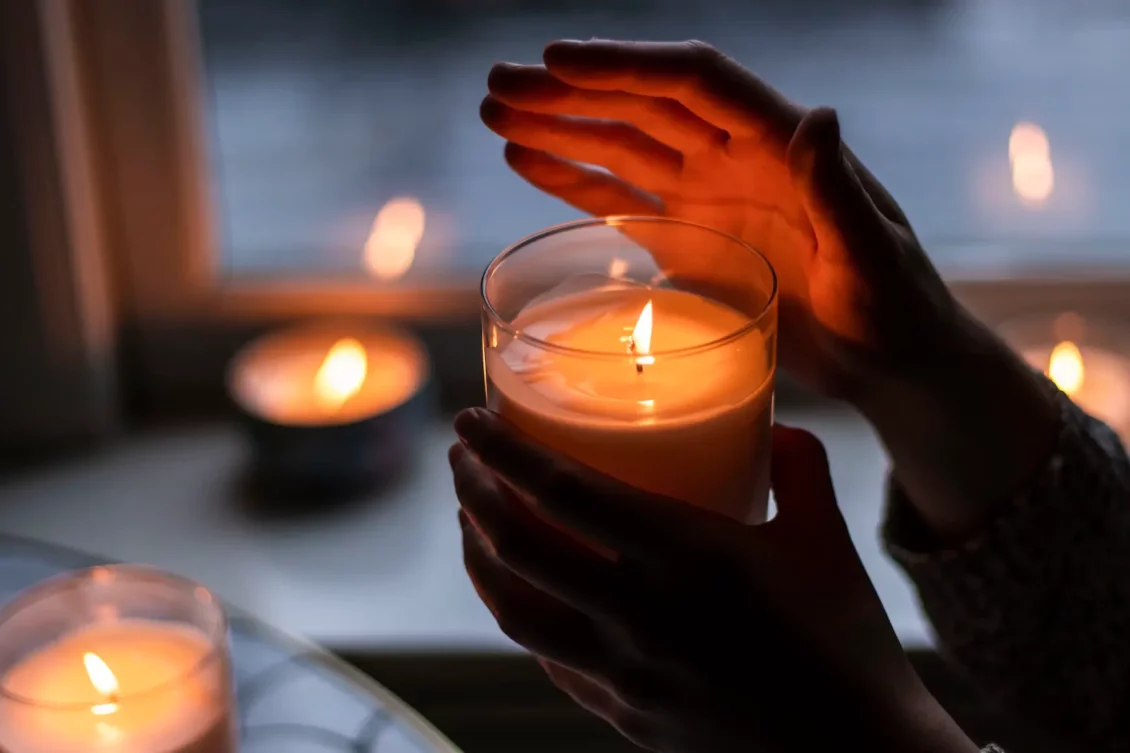Tag: scented candle
HOW TO BURN CANDLES SAFELY
Using candles safely in your home is incredibly important. Burning an open flame indoors should be taken seriously at all times to keep yourself, your family, and your property safe – fire can be deadly. Please read this guide thoroughly before lighting your new scented candle inside your home.
- Read This Post Before Burning…
- Our Candle Burning Top Tips
- How A Candle Works
- The Most Important Candle Safety Rules
- What To Do Before Lighting A Candle
- Remember These Rules While Burning Candles
- What To Do If Your Candle Isn’t Burning Correctly
- How To Extinguish Your Scented Candle Safely
Read This Post Before Burning…
We take candle safety extremely seriously here at AURA, and believe that these handy tips will help you stay safe while enjoying scented candles at home.
Before lighting your candle for the first time we recommend reading through the following information. As always, if you have any questions at all, please don’t hesitate to drop us a line!
Our Candle Burning Top Tips
Don’t have time to read this full article right now? No worries. We highly recommend taking the time to go through all our candle safety information, but in the meantime here are our top tips for burning scented candles.
- For optimal burning, trim your wick to 3mm before each lighting to avoid smoking and overheating.
- Always protect the surface on which the candle sits.
- The first burn of any candle should be long enough for the entire top layer of wax to liquefy. This will ensure an even burn for each light.
- Refrain from burning candles longer than 3 hours at a time, and never burn a candle when there is less than 1cm of wax at the base.
- Never leave a candle burning unattended or within reach of drafts, pets, or small children.
- The candle jar will be hot after burning, so allow the wax to cool completely before handling
- Once the flame is extinguished make sure the wick is upright and centred.
- Extinguish the flame carefully by snuffing it rather than blowing on it.
How a Candle Works
Candles generate both light and heat through the simple process of combustion.
While it looks like the candle’s wick is on fire, it is actually just supporting the flame; it is the wax that is burning. This happens because the wick is absorbent; it draws molten wax up towards the flame, where the wax ignites and vaporises.
The burning wax vapour produces most of the light and heat. This is why the candle’s wick lasts so long, it is simply acting as a kind of fuel line. Once the wax has been used up, the candle can no longer be burnt as there is no longer any fuel for the fire.
The Most Important Candle Safety Rules
Candle safety is all about remembering that a candle is an open flame and treating it accordingly. As long as the candle is treated with the respect it deserves, problems are unlikely.
If people in the home are going to be careless with candles, they are quite literally playing with fire.
- Never leave a lit candle unattended.
- Never burn a candle on or near anything that might catch fire.
- Keep candles out of the reach of children and pets.
What To Do Before Lighting A Candle
Trim the wick
Before you light a candle for the first time, or relight a used candle, you must trim the wick down to about 5mm. Long or crooked wicks can cause uneven burning, dripping or flaring.
Burn candles in a well-ventilated room.
Don’t burn too many candles in a small room or in a “tight” home where air is limited.
Place the candle away from anything flammable.
Make sure that there is nothing flammable in the vicinity of your scented candle. Keep burning candles away from furniture, curtains and drapes, bedding, carpets, books, paper, flammable decorations, clothing, hair etc.
Don’t place your candles under shelves as there is a lot of heat above a burning candle. There should be at least 1m between the candle flame and the surface above it.
Place the candle on a stable, heat-resistant surface.
We recommend using a candle holder specifically designed for candle use. The holder should be heat resistant, sturdy, and large enough to catch any drips or hot melted wax.
Always put candles including ones already in containers on a heat resistant surface. You should be especially careful with night lights and tea lights, as they can get hot enough to melt plastic
It is also important to make sure the holders are set on flat, stable surfaces to minimise the chance they will tip over.
Keep the wax pool clear
Make sure your candle is free of wick trimmings, matches and debris at all times as these things can catch fire.
Avoid drafts, vents or air currents.
Making sure that you place the candle away from any drafts, vents, fans or air currents will prevent rapid and uneven burning, avoid flare-ups and sooting. Strong drafts could also blow nearby lightweight items into the flame where they could catch fire.
While candles do require ventilation so that they do not exhaust the oxygen in the room, they should also be kept away from drafts in order to ensure a controlled burn.
Follow the manufacturer’s recommendations
Each candle is different so make sure that you thoroughly read and follow each manufacturers instructions on correct lighting, burning and extinguishing. Don’t burn a candle longer than the manufacturer recommends.
Remember These Rules While Burning Candles
Never touch or move a burning candle
Once the candle is lit, never touch or move it. It is dangerous to pickup the candle while it is still burning or while the liquid wax is hot.
Don’t burn a candle all the way down.
Don’t burn your candle all the way to the bottom. It is generally recommended to stop using the candle once there is only 1cm of wax left if it is a container candle. This ensures that the wick remains vertical and that the burn stays under control the whole time.
Place burning candles at least three inches apart from one another.
When arranging candles make sure that burning candles are placed at least 10cm away from each other. This will help stop the candles melting each other or creating their own drafts which would cause uneven and improper burning.
Extinguish a candle if the flame becomes too high or flickers repeatedly
Let the candle cool, and follow the instructions further along in this guide before re-lighting.
Always keep the candle within your sight.
Burning a candle is a potential fire hazard and even when you have followed all the other safety advice within this article, you must never leave a lit candle burning unattended. Fire is unpredictable, so always be aware of how your candle is behaving.
If you are going to leave the room, be sure to first blow out all candles. It is a simple rule for anything that burns; fires should never be left unattended. This is particularly true of candles, as some can easily tip over, greatly increasing the chance of fire. The presence of pets just adds to the danger. Seconds matter when it comes to fire, and unattended fires mean that there is not one present to take action in the most important seconds. It simply is not worth the risk.
Never use a candle as a night light.
All candles should be extinguished before you go to sleep.
Be very careful if using candles during a power outage.
Torches and other battery-powered lights are safer sources of light during a power failure. Never use a candle during a power outage to look for things in a closet, or when fueling equipment – such as a lantern or kerosene heater.
Never burn a candle on or near anything that can catch fire.
Keep burning candles away from furniture, curtains, bedding, carpets, books, paper, flammable decorations, etc.
Fire thrives on oxygen, and using candles in a household where someone uses oxygen is courting disaster. The additional oxygen accelerates combustion and turns almost any spark into a runaway fire. While oxygen tanks are enclosed and can be kept far away from candle flames, it simply is not worth the risk to burn a candle anywhere in the vicinity of oxygen.
Keep candles out of the reach of children and pets.
Do not place lighted candles where they can be knocked over by children, pets or anyone else.
What To Do If Your Candle Isn’t Burning Correctly
If your candle begins to smoke, flicker, or the flame becomes too high, you must take the following steps.
- Extinguish the candle
- Let it cool
- Trim and recenter the wick.
- Check for drafts before relighting
How To Extinguish Your Scented Candle Safely
Use a candle snuffer
It is always best to use a snuffer when extinguishing candles. Snuffing out the candle using a specially made snuffer is the safest way to avoid accidentally knocking over the candle and preventing hot wax splatters.
A candle snuffer starves the flame of oxygen, ensuring that it goes out gently, without giving the wax a chance to spatter. It is the safest way to douse a candle without worrying about spatter or burning one’s fingers on the wick.
You can also use a metal spoon if you don’t own a snuffer.
Never use water to extinguish a candle.
The mixture of cold water and hot wax can send the wax splattering everywhere, possibly leading to burns. The cold water can also be dangerous to glass candle holders, as the sudden drop in temperature can cause the glass to crack, potentially spilling hot wax everywhere.
Make sure the candle is fully extinguished
Before leaving the room or falling asleep check that the candle is fully out. Be sure that the wick ember has stopped glowing.
Don’t touch or move the candle until it has completely cooled.
Never use a knife or sharp object to remove wax drippings from a glass holder.
It might scratch, weaken, or cause the glass to break upon subsequent use.
Scented candles are a beautiful addition to any room, but you must always remember that any open flame should be treated with respect. Please follow this guide carefully and if you have any questions about how to safely burn your candles you can drop us a line at aura@upohar.xyz



